 THE
BLUE HOUR/ONE NAKED NIGHT/THREE
IN A TOWEL (1971/1965/1969)
THE
BLUE HOUR/ONE NAKED NIGHT/THREE
IN A TOWEL (1971/1965/1969)Director(s): Sergei Goncharoff/Albert T. Viola/Marty Rackum
Vinegar Syndrome
 THE
BLUE HOUR/ONE NAKED NIGHT/THREE
IN A TOWEL (1971/1965/1969)
THE
BLUE HOUR/ONE NAKED NIGHT/THREE
IN A TOWEL (1971/1965/1969)Vinegar Syndrome’s latest DVD presents the disparate sexploitation output of the mysterious distributor Grads Corp.
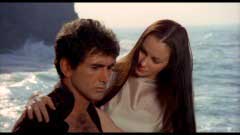
THE BLUE HOUR – or L’HEURE BLEU as the title appears onscreen, although they’re fooling no one into thinking this is a foreign production – is the story of Tania, a Greek girl who flees her island home under a dark cloud and ends up on the Nevada farm of a distant uncle. When he forces his attentions on her, she flees into the desert carrying on a statue of Pan that was given to her back home by an amorous shepherd who her mother believed had bewitched her with designs on her virginity. She is picked up in the middle of a desert by a motorist who turns out to be the procurer of a Los Angeles “modeling” agency, and soon becomes their major money-maker. When a cowboy sees her in the desert on a shoot, it’s love at first sight; but her employers are not happy about her leaving and tragedy ensues. Eventually, she becomes involved with divorced architect David (Edward Blessington, THE TALE OF THE DEAN’S WIFE), but the demons of her past stretching all the way back to the scandal that caused her to leave home in the first place threaten any chance of happiness for the couple.
 THE
BLUE HOUR is hard to judge in its finished form, coming across as an arty drama
with a host of limply executed sexploitation scenarios (farm girl’s sexual
awakening and exploitation, nice guy – or guys, here – falls for
fallen woman, nude modeling agency as a front for prostitution). The film’s
original cut – whatever that may have been – was given a massive
overhaul with a reshot footage featuring the original actress and a new character
in David’s architect. The lead – presumably first-billed “Ann
Chapman” – who looks at times like Susan Strasberg – isn’t
compelling enough for the story (although she is certainly hampered by having
the direction which has her speaking unaccented English during the Greek sequences
but then with a more stilted accent during the reshoot scenes in which she’s
the foreigner among American characters), and visual references to Greek mythology
(and “Alice in Wonderland”) just see pretentious (it’s also
hard to take the young priest character seriously in that mock-up of a Greek
cassock, although other attempts at establishing the Greek setting for the flashbacks
fare better). I didn’t recognize any of the cast names and very few of
the crew names (and I get the impression we’re not supposed to), but there
are a few familiar participants here. Direction and editing of the original
cut is credited to film editor Sergei Goncharoff and photography to Robert Maxwell
(BLOOD MANIA) – Maxwell’s wife Nora served as make-up artist –
who both later worked on HOUSE OF TERROR (Goncharoff’s only directorial
effort listed at IMDb). Additional scenes are credited to Ron Nicholas and photographed
by Don Jones. Jones is the cinematographer/director of films like SCHOOLGIRLS
IN CHAINS and THE FOREST, both of which featured actor Gary Kent who is credited
here as one of the film’s production managers (although the separate credits
for himself and Len Bram [SE7EN] suggest that Kent came on as part of the reshoot).
THE
BLUE HOUR is hard to judge in its finished form, coming across as an arty drama
with a host of limply executed sexploitation scenarios (farm girl’s sexual
awakening and exploitation, nice guy – or guys, here – falls for
fallen woman, nude modeling agency as a front for prostitution). The film’s
original cut – whatever that may have been – was given a massive
overhaul with a reshot footage featuring the original actress and a new character
in David’s architect. The lead – presumably first-billed “Ann
Chapman” – who looks at times like Susan Strasberg – isn’t
compelling enough for the story (although she is certainly hampered by having
the direction which has her speaking unaccented English during the Greek sequences
but then with a more stilted accent during the reshoot scenes in which she’s
the foreigner among American characters), and visual references to Greek mythology
(and “Alice in Wonderland”) just see pretentious (it’s also
hard to take the young priest character seriously in that mock-up of a Greek
cassock, although other attempts at establishing the Greek setting for the flashbacks
fare better). I didn’t recognize any of the cast names and very few of
the crew names (and I get the impression we’re not supposed to), but there
are a few familiar participants here. Direction and editing of the original
cut is credited to film editor Sergei Goncharoff and photography to Robert Maxwell
(BLOOD MANIA) – Maxwell’s wife Nora served as make-up artist –
who both later worked on HOUSE OF TERROR (Goncharoff’s only directorial
effort listed at IMDb). Additional scenes are credited to Ron Nicholas and photographed
by Don Jones. Jones is the cinematographer/director of films like SCHOOLGIRLS
IN CHAINS and THE FOREST, both of which featured actor Gary Kent who is credited
here as one of the film’s production managers (although the separate credits
for himself and Len Bram [SE7EN] suggest that Kent came on as part of the reshoot).
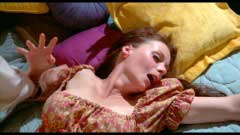
On the commentary for BLOOD MANIA, director Robert Vincent O’Neil said that you could tell the difference between Maxwell’s work and Gary Graver’s by the depth in Maxwell’s lighting and framing; and that seems to be the case here with Jones photography looking flatter and more evenly lit. I’m not certain if Ron Nicholas is the same guy as the TV actor listed at IMDb, but I’m guessing he is the same guy that produced Gary Graver’s SANDRA: THE MAKING OF A WOMAN (which also featured Blessington, as well as Jones as gaffer and Kent as production manager) since it was also released by Grads Corp., and they might have recruited him to make something out of what was the original cut of THE BLUE HOUR. The film’s post-production slow motion, optical zooms into freeze frames, fades to white, and the splicey “avant-garde” quick-cut montages were also very much in evidence in the later HOUSE OF SEVEN CORPSES, on which both Kent and Jones worked (and makes one wonder if Jones had did some post-production tinkering on that picture). Two songs are credited as having been penned by musician Bobby Troup who was best known for writing the song “Route 66” (and would go on to become a regular cast member of the TV series EMERGENCY) – although the Sylvia Wilson-penned “Can I Live Again” is catchier – but even more shocking is the appearance of an actor who looks and sounds startlingly like W.K.R.P. IN CINCINATTI’s Gordon Jump as one of David’s investors (whose wife was played by 1940s B-movie starlet Mary Beth Hughes). I'm not sure if actually is him, but I did a double take. The music is credited to one Harry Fields (actually, it’s “A Harry Fields Enterprise”) but music supervision is credited to composer Bert Shefter (THE LAST MAN ON EARTH) – who compiled stock music cues for films like TEENAGE ZOMBIES and NIGHTMARE IN WAX in between prolific TV assignments – and orchestral Al Sendrey. Ultimately, THE BLUE HOUR is a fascinating curio, but hardly a feather in the cap of director Goncharoff.
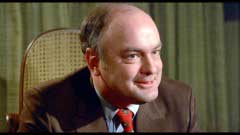 Vinegar
Syndrome’s single-layer, progressive, anamorphic widescreen (1.85:1) transfer
of THE BLUE HOUR was derived from a 2K transfer of the film’s original
35mm negatives, and the condition is largely flawless apart from some rare scratches
(some bumpy shot changes during the quick cut montages are likely the fault
of their assembly rather than any condition issues with the negatives). The
Dolby Digital 2.0 mono audio is crackly throughout, but not enough to distract.
There are no extras related to the film, not even a theatrical trailer, and
I’m wondering just how widely this was released. It has no IMDb entry
and I could find no posters for the film.
Vinegar
Syndrome’s single-layer, progressive, anamorphic widescreen (1.85:1) transfer
of THE BLUE HOUR was derived from a 2K transfer of the film’s original
35mm negatives, and the condition is largely flawless apart from some rare scratches
(some bumpy shot changes during the quick cut montages are likely the fault
of their assembly rather than any condition issues with the negatives). The
Dolby Digital 2.0 mono audio is crackly throughout, but not enough to distract.
There are no extras related to the film, not even a theatrical trailer, and
I’m wondering just how widely this was released. It has no IMDb entry
and I could find no posters for the film.

The second disc in the set is an incredibly odd dual-layer double feature of ONE NAKED NIGHT by writer/actor Albert T. Viola (THE NIGHT THEY RAIDED BIG BERTHA’S) and the unclassifiable THREE IN TOWEL. In ONE NAKED NIGHT, virginal schoolgirl Candy (Barbara Morris) is in for a rude awakening when her mother commits suicide. The revelation that her mother was a call girl causes her respectable fiancé to call off their wedding and the townspeople to look down upon her. As the film opens, she has decided to start a new life in New York. Moving into a large apartment with her childhood friend Laura (Sally Lane) who lives with model Peg and older Barbara (Audrey Campbell, SIN IN THE SUBURBS), Candy is surprised that the women make their living entertaining male clients but she doesn’t judge them. She even decides to do some posing for photographer Charlie (Ian Miller) who charms her off her feet. Although Barbara – who harbors a lesbian attraction to Candy – tries to warn her off Charlie (“all men are either deadly dull or rotten”), Candy is convinced that Charlie is different until she catches him sleeping with another of his models. Unable to face Barbara or Laura, she races into the arms of “nice guy” sculptor Joe (Joe Marshall) but their happiness is short-lived when she realizes that she’ll always be second to his work. Wanting to be desired, Candy returns to her apartment and falls into her roommates’ exciting lifestyle only to realize too late that she has forgotten her own conviction not to become like her mother.
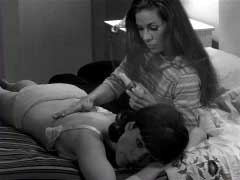 ONE
NAKED NIGHT is a real downer of a sexploitation picture. A 1965 production,
it has little nudity but is pretty frank about its sexuality (Candy is the only
person on either side of the screen that is shocked that Charlie turns out to
be a womanizer). Campbell gives the best performance with Morris not far behind
(although her naiveté becomes even more grating with her incessant narration,
describing New York as being “like an exquisite art gallery full of old
masters and weird new forms”). More interesting is the uncredited monochrome
cinematography (IMDb lists director Viola as the film’s camera operator)
which beautifully captures a neon New York at night (there are some picturesque
daytime shots as well) from the sidewalks to the nightclubs, as well as an odd
apartment orgy lit by the flickering beam of a projector showing a stag film
that seems oddly “Lynchian”; however, there are just as many shots
where the focus pulling is lazy. The jazz score by Chet McIntrye was actually
released on LP in 1965.
ONE
NAKED NIGHT is a real downer of a sexploitation picture. A 1965 production,
it has little nudity but is pretty frank about its sexuality (Candy is the only
person on either side of the screen that is shocked that Charlie turns out to
be a womanizer). Campbell gives the best performance with Morris not far behind
(although her naiveté becomes even more grating with her incessant narration,
describing New York as being “like an exquisite art gallery full of old
masters and weird new forms”). More interesting is the uncredited monochrome
cinematography (IMDb lists director Viola as the film’s camera operator)
which beautifully captures a neon New York at night (there are some picturesque
daytime shots as well) from the sidewalks to the nightclubs, as well as an odd
apartment orgy lit by the flickering beam of a projector showing a stag film
that seems oddly “Lynchian”; however, there are just as many shots
where the focus pulling is lazy. The jazz score by Chet McIntrye was actually
released on LP in 1965.

THREE IN A TOWEL purports to be the erotic fantasy of a man named Romeo who can only fully realize his virility in dreams. In his dream, he effortlessly picks up Joy whose chastity surely “incarnate in her maidenhead” with designs on her virginity, but she blows him off when she discovers that their day out on the water includes his “cruise crew” trio of skanky nymphs. Not to waste the day, he takes his crew out onto the water and sleeps with each of them individually while the others suggestively eat bananas and slurp on cold cuts in a manner that is anything but sexy (although it purports to be). Halfway through, it seems we can be thankful the trio have hopped ship and ditched this Romeo dud; but instead, we follow him as he uses his “thought waves” to invite four more easy women to his apartment for an afternoon orgy, although one inexplicably disappears in order for there to be THREE IN A TOWEL (or rather three under a towel).
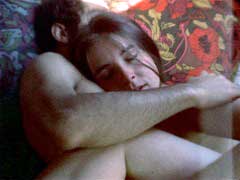 Looking
like a naughty home movie dubbed by non-actors (possibly actually the voices
of those onscreen), THREE IN A TOWEL – or 3 IN A TOWEL as it appears onscreen
(many times) – is so painful it must have made several of the raincoat
crowd question if discreetly heading down to 42nd Street was worth the effort
to see some boobs (the only real anticipation comes not from how explicit the
ensuing sex will be, but if it might on the off-chance suddenly turn into a
snuff film). The audio seems to have been recorded one-take-only so Romeo trips
over his own narration when quoting Shakespeare, and the soundtrack features
Shakespearean quotes from other voice actors of varying talent (from “thespians”
to what sounds like high school students cold reading the plays). Worst yet
is the dubbing of “cruise crew” which sounds almost like one of
the “Film Dub” exercises of the improv show WHOSE LINE IS IT ANYWAY?
without the comedy (intentioned or otherwise). The sound effects track is maddening
with the lapping waves during the boat scenes sounding like someone wringing
out a mop into a bucket of water over and over again. I’m not quite sure
how to take the production company Miracle Pictures motto: “Remember,
if it’s a good picture, it’s a miracle!”
Looking
like a naughty home movie dubbed by non-actors (possibly actually the voices
of those onscreen), THREE IN A TOWEL – or 3 IN A TOWEL as it appears onscreen
(many times) – is so painful it must have made several of the raincoat
crowd question if discreetly heading down to 42nd Street was worth the effort
to see some boobs (the only real anticipation comes not from how explicit the
ensuing sex will be, but if it might on the off-chance suddenly turn into a
snuff film). The audio seems to have been recorded one-take-only so Romeo trips
over his own narration when quoting Shakespeare, and the soundtrack features
Shakespearean quotes from other voice actors of varying talent (from “thespians”
to what sounds like high school students cold reading the plays). Worst yet
is the dubbing of “cruise crew” which sounds almost like one of
the “Film Dub” exercises of the improv show WHOSE LINE IS IT ANYWAY?
without the comedy (intentioned or otherwise). The sound effects track is maddening
with the lapping waves during the boat scenes sounding like someone wringing
out a mop into a bucket of water over and over again. I’m not quite sure
how to take the production company Miracle Pictures motto: “Remember,
if it’s a good picture, it’s a miracle!”
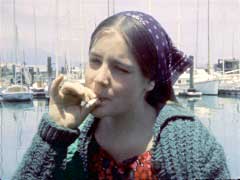 Previously
released on VHS by Something Weird Video and Alpha Blue Archives, ONE NAKED
NIGHT comes to Vinegar Syndrome in a gorgeous progressive, fullscreen transfer
that often makes the film look classier than it really is. The progressive,
fullscreen transfer of THREE IN A TOWEL looks as good as it can with lens flare
diluting colors and detail during the exterior boat scenes (colors are vivid
in the more controlled lighting of Romeo’s apartment). The Dolby Digital
2.0 mono tracks on both films feature a non-disruptive layer of hiss. The only
extra is a trailer for THREE IN A TOWEL (2:52) that promises more than this
film can actually be bothered to muster. (Eric
Cotenas)
Previously
released on VHS by Something Weird Video and Alpha Blue Archives, ONE NAKED
NIGHT comes to Vinegar Syndrome in a gorgeous progressive, fullscreen transfer
that often makes the film look classier than it really is. The progressive,
fullscreen transfer of THREE IN A TOWEL looks as good as it can with lens flare
diluting colors and detail during the exterior boat scenes (colors are vivid
in the more controlled lighting of Romeo’s apartment). The Dolby Digital
2.0 mono tracks on both films feature a non-disruptive layer of hiss. The only
extra is a trailer for THREE IN A TOWEL (2:52) that promises more than this
film can actually be bothered to muster. (Eric
Cotenas)